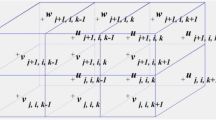Abstract
The role of the ‘tidal vortex’ in the mechanism of generation of tidal residual circulation is investigated for a bay with a narrow entrance channel. It is shown that the circulation of residual flow is produced not by the vorticity of the inflowing sidewall-boundary layer, but by a tidal vortex formed by rolling up of the discontinuity surface released from the flow separation point at the entrance. This tidal vortex is affected by the circulation of the inflowing water, that is the inflowing tidal vortex. A returning tidal vortex formed in the bay diminishes the circulation of the tidal vortex of the next generation, while the inflowing tidal vortex formed in the open sea increases it. These cases correspond to tidal vortex life-histories of type-II and type-III, respectively (Kashiwai, 1984a). Tidal vortices of each life-history type have different strength and produce residual circulation of different strength, corresponding to each type. The ratio of kinetic energy of residual flow to that of the tidal current through the bay entrance, that is to say the energy gain of the residual circulation, is proportional to the reciprocal of the Strouhal number, and its rate of increase depends on the life-history type of the tidal vortex. This explains the experimental observation reported by Oonishi (1977) and Yanagi (1978) that the energy ratio of residual flow to tidal flow increases with the Reynolds number not monotonously but goes through a maximum and a minimum at intermediate Reynolds number.
Similar content being viewed by others
References
Ferentinos, G. and M. Collins (1979): Tidally induced secondary circulation and their associated sedimentation process. J. Oceanogr. Soc. Japan,35, 65–74.
Fujiwara, S. (1941): Experiments on vortex. In: Experimental Physics, Vol. 11, Kawade-Shobo, Tokyo, pp. 31–75. (in Japanese)
Kashiwai, M. (1984a): Tidal residual circulation produced by a tidal vortex, Part 1; Life-history of a tidal vortex. J. Oceanogr. Soc. Japan,40, 279–294.
Kashiwai, M. (1985): A hydraulic experiment on the tidal exchange. J. Oceanogr. Soc. Japan (in press)
Oonishi, Y. (1977): A numerical study on the tidal residual flow. J. Oceanogr. Soc. Japan,33, 207–218.
Robinson, I.S. (1981): Tidal vorticity and residual circulation. Deep-Sea Res.,28, 195–212.
Sugimoto, T. (1975): Effect of boundary geometries on tidal currents and tidal mixing. J. Oceanogr. Soc. Japan,31, 1–14.
Yanagi, T., M. Kashiwai, H. Yasuda, Y. Kitagawa and H. Higuchi (1974): Fundamental study on the tidal residual circulation, Ann, Disaster Prev. Res. Inst., Kyoto Univ.,17B, 657–667, (in Japanese)
Yanagi, T. (1978): Fundamental study on the tidal residual circulation, II. J. Oceanogr. Soc. Japan,34, 67–72.
Yasuda, H. (1980): Generating mechanism of the tidal residual current due to the coastal boundary layer. J. Oceanogr. Soc. Japan,35, 241–252.
Author information
Authors and Affiliations
Rights and permissions
About this article
Cite this article
Kashiwai, M. Tidal residual circulation produced by a tidal vortex. Journal of the Oceanographical Society of Japan 40, 437–444 (1984). https://doi.org/10.1007/BF02303071
Received:
Revised:
Accepted:
Issue Date:
DOI: https://doi.org/10.1007/BF02303071




